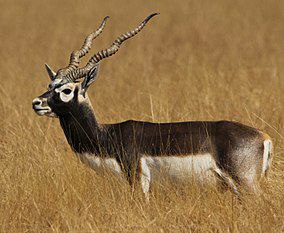🔆Caracal included in list of critically endangered species
▪️Why news
✅ The caracal, a medium-sized wildcat was recently included in the list of critically endangered
species.
✅Agencies: The National Board for Wildlife and Union Ministry of Environment
✅It is found in parts of Rajasthan and Gujarat.
▪️Important value additions
✅Some experts believe that the animal is on the verge of extinction in India.
✅The recovery programme for critically endangered species in India now includes 22 wildlife
species.
✅Besides India, the caracal is found across Africa, the Middle East, Central and South Asia.
✅While it flourishes in parts of Africa, its numbers in Asia are declining.
✅The wildcat has long legs, a short face, long canine teeth, and distinctive ears — long and pointy, with tufts of black hair at their tips.
🔆Green Skill Development Programme (GSDP):
✅GSDP is a recent initiative under the ENVIS scheme for skilling the youth in the country. It is an initiative for skill development in the environment and forest region by the Ministry of Environment, Forests & Climate Change (MoEF&CC) to develop India’s youth into employable and/or self-employment, making use of the widespread network and experience of ENVIS Hubs/RPs.
✅ The Green Skill Development programme endeavours to develop green skilled workers having technical knowledge and commitment to sustainable development, which will help in the attainment of the Intended Nationally Determined Contributions (INDCs), Sustainable Development Goals (SDGs) and National Biodiversity Targets(NBT).
✅Green skills are those skills required to adapt processes, services and products to climate change and the environmental rules and necessities related to it.
Blackbuck National Park, Velavadar
✅located at Velavadar in the Bhavnagar District of Gujarat state, India.
✅Flat land, dry grasses and herds of antelope have always attracted visitors to this park which has a grassland ecosystem. Successful conservation programs for the blackbuck, wolf and lesser florican (a bustard) are ongoing
✅A southern portion of the park, which adjoins the Gulf of Khambhat, is in the Gulf's high tide zone and gets inundated with water. However, its semi-arid conditions, together with this inundation of seawater during monsoon, creates habitats suitable for various dependent fauna of the park
Guru Ghasidas National Park
Located in Koriya district, Chaatisgarh
It is a part of the Sanjay-Dubri Tiger Reserve that is located within both Chhattisgarh and Madhya Pradesh.
The tropical climate of the park allows it to be the perfect home for tigers.
Other than tigers, the park is also home to deers, leopards, neelgai and chinkaras.
The dense forests have sal trees and many rivulets passing through the sanctuary. Best time to visit the park is between the months of November and May when the migratory birds are passing through the sanctuary.
🔆Spider monkeys
✅are New World monkeys belonging to the genus Ateles, part of the subfamily Atelinae, family Atelidae. Like other atelines, they are found in tropical forests of Central and South America, from southern Mexico to Brazil.
✅The sarus crane (Antigone antigone) is a large nonmigratory crane found in parts of the Indian subcontinent, Southeast Asia, and Australia.
✅The tallest of the flying birds, standing at a height up to 1.8 m (5 ft 11 in), they are a conspicuous species of open wetlands in South Asia, seasonally flooded Dipterocarpus forests in Southeast Asia, and Eucalyptus-dominated woodlands and grasslands in Australia.
🔆Critically Endangered Birds
🔸Aythya baeri
🔸Forest Owlet
🔸Great Indian Bustard
🔸Bengal Florican
🔸Siberian Crane
🔸Spoon-billed Sandpiper
🔸Sociable Lapwing
🔸Jerdon’s Courser
🔸White-backed Vulture
🔸Red-headed Vulture
🔸White-bellied Heron
🔸Slender-billed Vulture
🔸Indian Vulture
🔸Pink-headed Duck
🔸Himalayan Quail
🔆Komodo dragon
✅Komodo dragons are the largest and heaviest lizards on Earth.
✅They have long, flat heads with rounded snouts, scaly skin, bowed legs, and huge, muscular tails.
✅Komodo dragons can eat almost anything, including invertebrates, birds, and mammals like deer, pigs, and even large water buffalo.
✅They have venom glands loaded with toxins which have been shown to secrete anticoagulants.
✅The venom lowers blood pressure, causes massive bleeding, and induces shock.
▪️Conservation:
✅IUCN Status: Vulnerable.
✅CITES: Appendix I. (The commercial trading of live specimens or any parts, dead or alive of Komodo is prohibited.)
🔘Mandarin Duck
◾️Considered the most beautiful duck in the world, the Mandarin duck, or the (Aix galericulata) was first identified by Swedish botanist, physician, and zoologist Carl Linnaeus in 1758.
◾️It is a “small-exotic looking bird” native to East Asia.
◾️The migratory duck breeds in Russia, Korea, Japan, and the north-eastern parts of China, explained Gogoi.
◾️It now has established populations in Western Europe and America too.
◾️The duck, however, rarely visits India as it does not fall in its usual migratory route.
◾️Its IUCN status is Least Concern.
◾️While the duck is not a globally threatened species, spotting one is always considered significant because they only make “rare appearances.”
◾️The Maguri Motapung wetland — an Important Bird Area as declared by the Bombay Natural History Society — is located close to the Dibru Saikhowa National Park in Upper Assam.
🔘Green Steel
◾️Green Steel is the manufacturing of steel without the use of fossil fuels.
◾️This can be done by using low-carbon energy sources such as hydrogen, coal gasification, or electricity instead of the traditional carbon-intensive manufacturing route of coal-fired plants.
◾️It eventually lowers Green Gas Emissions cuts costs and improves the quality of steel.
◾️Low Carbon Hydrogen (Blue Hydrogen and Green Hydrogen) can help reduce the steel industry’s carbon footprint.
◾️ National Hydrogen Energy Mission capitalizes on hydrogen for a cleaner alternative fuel option.
🔘Climate Tipping Points
In News
According to a major study, the climate crisis has driven the world to the brink of multiple “disastrous” tipping points.
About
◾️Climate Tipping Points or CTPs are markers of a larger climate system which when triggered beyond a threshold, perpetuates warming on its own.
◾️According to the Study, five dangerous tipping points may already have been passed due to the 1.1 o C of global heating caused by humanity to date.
◾️These include the collapse of Greenland’s ice cap, eventually producing a huge sea level rise, the collapse of a key current in the north
◾️ Atlantic, disrupting rain upon which billions of people depend for food, and an abrupt melting of carbon-rich permafrost.
🔆Spider monkeys
✅are New World monkeys belonging to the genus Ateles, part of the subfamily Atelinae, family Atelidae. Like other atelines, they are found in tropical forests of Central and South America, from southern Mexico to Brazil.
✅The sarus crane (Antigone antigone) is a large nonmigratory crane found in parts of the Indian subcontinent, Southeast Asia, and Australia.
✅The tallest of the flying birds, standing at a height up to 1.8 m (5 ft 11 in), they are a conspicuous species of open wetlands in South Asia, seasonally flooded Dipterocarpus forests in Southeast Asia, and Eucalyptus-dominated woodlands and grasslands in Australia.
🔆Critically Endangered Birds
🔸Aythya baeri
🔸Forest Owlet
🔸Great Indian Bustard
🔸Bengal Florican
🔸Siberian Crane
🔸Spoon-billed Sandpiper
🔸Sociable Lapwing
🔸Jerdon’s Courser
🔸White-backed Vulture
🔸Red-headed Vulture
🔸White-bellied Heron
🔸Slender-billed Vulture
🔸Indian Vulture
🔸Pink-headed Duck
🔸Himalayan Quail
🔆Komodo dragon
✅Komodo dragons are the largest and heaviest lizards on Earth.
✅They have long, flat heads with rounded snouts, scaly skin, bowed legs, and huge, muscular tails.
✅Komodo dragons can eat almost anything, including invertebrates, birds, and mammals like deer, pigs, and even large water buffalo.
✅They have venom glands loaded with toxins which have been shown to secrete anticoagulants.
✅The venom lowers blood pressure, causes massive bleeding, and induces shock.
▪️Conservation:
✅IUCN Status: Vulnerable.
✅CITES: Appendix I. (The commercial trading of live specimens or any parts, dead or alive of Komodo is prohibited.)
🔘Mandarin Duck
◾️Considered the most beautiful duck in the world, the Mandarin duck, or the (Aix galericulata) was first identified by Swedish botanist, physician, and zoologist Carl Linnaeus in 1758.
◾️It is a “small-exotic looking bird” native to East Asia.
◾️The migratory duck breeds in Russia, Korea, Japan, and the north-eastern parts of China, explained Gogoi.
◾️It now has established populations in Western Europe and America too.
◾️The duck, however, rarely visits India as it does not fall in its usual migratory route.
◾️Its IUCN status is Least Concern.
◾️While the duck is not a globally threatened species, spotting one is always considered significant because they only make “rare appearances.”
◾️The Maguri Motapung wetland — an Important Bird Area as declared by the Bombay Natural History Society — is located close to the Dibru Saikhowa National Park in Upper Assam.
🔘Green Steel
◾️Green Steel is the manufacturing of steel without the use of fossil fuels.
◾️This can be done by using low-carbon energy sources such as hydrogen, coal gasification, or electricity instead of the traditional carbon-intensive manufacturing route of coal-fired plants.
◾️It eventually lowers Green Gas Emissions cuts costs and improves the quality of steel.
◾️Low Carbon Hydrogen (Blue Hydrogen and Green Hydrogen) can help reduce the steel industry’s carbon footprint.
◾️ National Hydrogen Energy Mission capitalizes on hydrogen for a cleaner alternative fuel option.
🔘Climate Tipping Points
In News
According to a major study, the climate crisis has driven the world to the brink of multiple “disastrous” tipping points.
About
◾️Climate Tipping Points or CTPs are markers of a larger climate system which when triggered beyond a threshold, perpetuates warming on its own.
◾️According to the Study, five dangerous tipping points may already have been passed due to the 1.1 o C of global heating caused by humanity to date.
◾️These include the collapse of Greenland’s ice cap, eventually producing a huge sea level rise, the collapse of a key current in the north
◾️ Atlantic, disrupting rain upon which billions of people depend for food, and an abrupt melting of carbon-rich permafrost.










